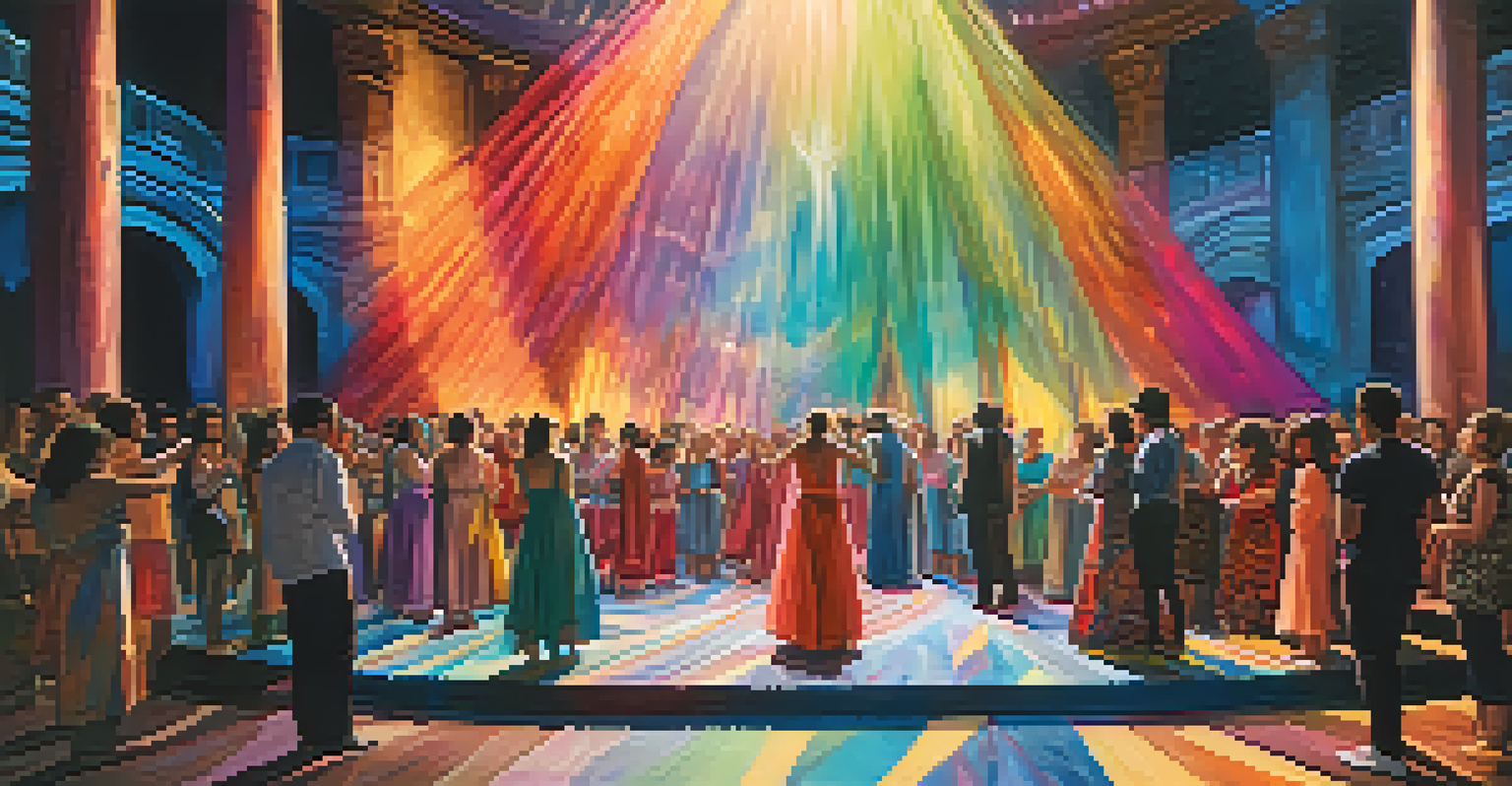The Impact of Theater in Portraying Spiritual Transformations

Theater as a Reflection of Spiritual Journeys
Theater has long been a mirror reflecting the human experience, including our spiritual journeys. Through storytelling, actors bring to life the inner struggles and triumphs we face, allowing audiences to see their own paths mirrored on stage. This connection fosters a deeper understanding of personal growth and transformation, making the spiritual journey relatable. By engaging with these narratives, viewers can reflect on their own beliefs and experiences, creating a shared space of exploration.
The theater is a place where the truth of our lives can be explored and expressed.
For example, plays like 'The Tempest' by Shakespeare explore themes of redemption and forgiveness, inviting audiences to consider their own spiritual awakenings. The characters' transitions often symbolize the struggles we all face in seeking meaning and connection. As the audience witnesses these transformations, they may find inspiration to embark on their own journeys of self-discovery and reflection. This deep-rooted connection is what makes theater an invaluable tool in exploring spirituality.
Ultimately, theater not only entertains but also prompts introspection, guiding individuals on a path of spiritual understanding. The emotional resonance of the performances serves as a catalyst for personal growth, encouraging viewers to confront their own spiritual questions. In this way, theater becomes a powerful conduit for exploring the complexities of human spirituality.
Characters as Symbols of Spiritual Transformation
Characters in theater often serve as symbols of spiritual transformation, embodying the struggles and triumphs we all face. These figures allow the audience to explore complex themes through relatable narratives, illustrating that change is both possible and necessary. For instance, the character of Scrooge in 'A Christmas Carol' showcases a profound spiritual awakening as he confronts his past and makes amends. This transformation not only impacts Scrooge but also resonates with the audience, prompting them to reflect on their own lives.

Moreover, these characters often navigate moral dilemmas and existential crises, providing a framework for the audience to consider their beliefs. The journey from ignorance to enlightenment is a common thread, enabling viewers to witness the process of shedding old beliefs and embracing new perspectives. This not only deepens their engagement with the story, but also invites them to contemplate their spiritual journeys in a personal context.
Theater Mirrors Spiritual Journeys
Theater reflects personal spiritual growth, allowing audiences to recognize and explore their own beliefs through storytelling.
By connecting with these characters, audiences can experience vicarious transformations that inspire real-life change. The stories unfold not just on stage but also within the hearts of the viewers, encouraging them to seek their own paths to spiritual fulfillment. In this sense, theater becomes a shared experience of growth and enlightenment.
The Role of Symbolism in Theater's Spiritual Themes
Symbolism plays a significant role in theater, enhancing the portrayal of spiritual themes. Objects, colors, and actions often carry deeper meanings, enriching the narrative and inviting audiences to explore their significance. For instance, the use of light and darkness in a play can symbolize the struggle between ignorance and enlightenment, guiding viewers to reflect on their own spiritual battles. This layering of meaning encourages a more profound engagement with the material.
The play's the thing wherein I'll catch the conscience of the king.
Consider the symbolic use of water in plays like 'The Glass Menagerie,' where it represents both cleansing and emotional turmoil. Through such symbolism, theater can evoke feelings and thoughts that resonate on a spiritual level. Audiences are invited to decipher these symbols, leading to a personal interpretation of the character's journey and their own spiritual experiences.
This deeper understanding of symbolism allows theater to transcend mere entertainment, becoming a powerful medium for exploring spirituality. It prompts viewers to question their own beliefs and experiences, leading to a transformative experience that lingers long after the final curtain. In this way, theater serves as a canvas for exploring the intricacies of the human spirit.
The Impact of Audience Engagement on Spiritual Reflection
Audience engagement is crucial in theater, especially when it comes to spiritual reflection. The dynamic interaction between performers and viewers creates a shared emotional experience that can lead to profound insight. When audiences are actively engaged, they are more likely to reflect on the spiritual themes presented, making the experience personal and impactful. This connection transforms passive viewing into an active exploration of one's beliefs and values.
For example, immersive theater experiences invite the audience to participate in the story, breaking down the barriers between performer and viewer. This participatory approach can lead to heightened emotional responses and deeper reflections on spiritual themes. When individuals feel personally involved, they are more likely to consider how the themes resonate with their own lives and journeys.
Characters Inspire Transformation
Through relatable characters, theater illustrates the journey from ignorance to enlightenment, prompting viewers to reflect on their own lives.
Ultimately, the impact of audience engagement in theater fosters a collective exploration of spirituality. As viewers share their emotional responses, they contribute to a communal understanding of the themes presented. This shared journey not only enhances the theatrical experience but also encourages personal growth and transformation.
Transformative Themes in Contemporary Theater
Contemporary theater continues to explore transformative themes that resonate with modern audiences. Issues such as identity, belonging, and personal growth are often highlighted, reflecting the spiritual struggles of today's society. By addressing these themes, playwrights create narratives that challenge audiences to confront their own beliefs and assumptions. This relevance helps theater remain a vital tool for exploring spirituality in a rapidly changing world.
For instance, plays like 'Dear Evan Hansen' tackle themes of mental health and connection, encouraging audiences to explore their own vulnerabilities. Such narratives foster a sense of empathy and understanding, prompting viewers to reflect on their own spiritual journeys. This connection between the themes and the audience's experiences enhances the overall impact of the performance.
By engaging with contemporary themes, theater invites audiences to participate in a dialogue about spirituality. This ongoing conversation encourages personal reflection and growth, showcasing the power of theater in addressing complex spiritual issues. As a result, contemporary theater remains an essential platform for exploring the human experience.
The Influence of Cultural Context on Spiritual Portrayals
Cultural context plays a significant role in shaping how spiritual transformations are portrayed in theater. Different cultures bring unique perspectives and narratives that influence the themes and symbols used in performances. For example, Eastern philosophies may emphasize collective consciousness and harmony, while Western narratives often focus on individualism and personal redemption. These cultural lenses enrich the portrayal of spiritual themes, allowing for diverse interpretations and experiences.
Moreover, understanding the cultural context can enhance the audience's engagement with the material. When viewers are aware of the cultural nuances, they can appreciate the depth of the characters' journeys and the significance of the themes presented. This awareness fosters empathy and connection, allowing audiences to reflect on their own spiritual beliefs in relation to the cultural narratives being portrayed.
Cultural Context Shapes Themes
The portrayal of spirituality in theater is influenced by cultural contexts, enriching narratives and offering diverse perspectives on human experience.
Ultimately, the influence of cultural context on spiritual portrayals in theater highlights the richness of the human experience. By embracing diverse narratives, theater can present a more holistic view of spirituality, encouraging audiences to explore their own beliefs within a broader context. This intersection of culture and spirituality makes theater a powerful medium for personal transformation.
The Future of Theater in Portraying Spiritual Transformations
As we look to the future, the role of theater in portraying spiritual transformations is likely to evolve. With advances in technology and shifts in societal values, new forms of storytelling will emerge, further enhancing the spiritual exploration in theater. For example, virtual reality experiences could allow audiences to immerse themselves in narratives, deepening their emotional and spiritual engagement. This evolution presents exciting opportunities for theater to continue its legacy as a platform for exploring the human spirit.
Additionally, the rise of diverse voices in theater will contribute to a richer exploration of spirituality. As more playwrights from various backgrounds share their stories, audiences will be exposed to a wider array of spiritual experiences and beliefs. This inclusivity not only enhances the theatrical landscape but also encourages audiences to reflect on their own spiritual journeys in relation to others.

In conclusion, the future of theater holds immense potential for portraying spiritual transformations. By embracing new technologies and diverse narratives, theater can continue to inspire and challenge audiences to explore their own spirituality. As we move forward, the powerful connection between theater and spirituality will remain an essential part of the human experience.